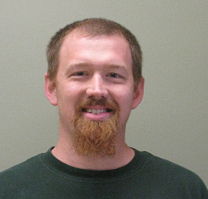
Wow! We had a really hard rain Tuesday afternoon as you can see in the picture above. My car was at the foot of the waterfall before I took this picture. While my biodiesel jetta needed a car wash, this was a bit much! The section of the building from which this water is coming is slated for removal thanks to a grant from the Golden Leaf Foundation. The roof in that area leaks severely. Yesterday I really wanted one of the old 6400 gallon tanks to catch some of this water. Rainwater catchment is on my to do list now. The guys next door to me in ceramics filled one of those old tanks yesterday with rainwater from the roof of the clay factory, which they will use to make and sell local clay. Check out the STARworks Ceramics website for more information.
The picture below is a shot of the two inline Bell & Gossett water pumps which circulate water and glycol through the heat exchanger on the furnace in our glass studio. I mentioned in my last post that Jim Gosnell and I installed these little guys. Did I mention they are really quiet? I have to hug the tank(carefully) to try and hear the water returning from the furnace. There are now 3 of these pumps for the process heat system, each of which consumes less energy than a 100 watt incandescent bulb. Many thanks to Jim for all his hard work on this project!


Hopefully you can read the numbers in the readout below. The top number, 181, refers to the temperature in fahrenheit of the process heat tank. The smaller number below,130, is the set point for the auxiliary 6 kilowatt electric heater.

I was really excited to see this Monday morning because this is the highest temperature the process heat system has achieved solely on waste heat from the glass furnace. The tank gained almost 40F over the weekend. This temperature is not far from the most I will need in any of the procedures for making biodiesel and will help us save money. My next money-saving project involves installing radiant heat barriers on the reactor, which will also cool down the ambient temperature in the plant considerably.
Below is a picture of the golden fuel I make in the plant using waste veggie oil I collect from area restaurants and the North Carolina Zoo in Asheboro. Many thanks to everyone who contributes oil to our project! If you know anyone that wants their waste veggie oil collected by me to make biodiesel, just send me an email at tony@starworksnc.org or via phone, 910.428.9001.









